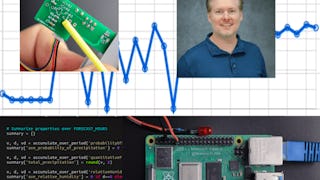In this course you will use a Raspberry Pi 4 to build a complete network-connected project with sensors and motors and access it from your smartphone. We'll explore all the parts which make this work, so you can use this experience as a foundation for your own projects. We'll use the Raspberry Pi as an "embedded system" (as opposed to a desktop computer) so you're ready to build a Raspberry Pi into your projects as the brains that make it all work. Want to build your own Internet of Things (IoT) device? Home automation? Robotics? This is the class to learn how it all works, to get you building on your own. No experience in embedded systems, programming, or electronics is assumed, and optional bonus sections are provided for those who want a fast start in Python programming, Linux essentials, and basic electronics. The course is divided into four modules to explore each focus area with demontrations and extras along the way: 1) installing and configuring a Raspberry Pi, 2) accessing the Raspberry Pi over the network, 3) programmatically controlling external sensors and motors, and 4) accessing the embedded device through a web interface. After these four modules you'll get started building your own projects right away, and the three follow-on courses in this Coursera specialization dive into each area to really boost your skills and the complexity of your projects. I hope you enjoy all the courses and I hope you take your builds to the next level.

Enjoy unlimited growth with a year of Coursera Plus for $199 (regularly $399). Save now.

Beginning Custom Projects with Raspberry Pi
This course is part of Raspberry Pi Projects Specialization

Instructor: Drew Wilson
8,488 already enrolled
Included with
(52 reviews)
Skills you'll gain
Details to know

Add to your LinkedIn profile
7 assignments
See how employees at top companies are mastering in-demand skills

Build your subject-matter expertise
- Learn new concepts from industry experts
- Gain a foundational understanding of a subject or tool
- Develop job-relevant skills with hands-on projects
- Earn a shareable career certificate

There are 4 modules in this course
In this module, we introduce the Raspberry Pi, and discuss how it is different from an Arduino. We will install and configure the operating system on a Raspberry Pi and connect to it via a network connection. If you’re not familiar with the Linux shell, there is an optional bonus section at the end of this module on Linux command line basics. Soon, we'll be using the pins on the Raspberry Pi to control things in the real world such as an LED.
What's included
14 videos2 readings2 assignments
As we enter this module, your Raspberry Pi is up and running on the network and we’ve done quite a lot on the Linux command line. In this module, we’ll connect to a full graphical desktop session over the network, learn some electronics theory and how we can use the GPIO pins to light an LED, and create a web API endpoint to toggle the LED and demonstrate how embedded devices can use simple web APIs for a control interface. At the end of this module is an optional bonus section on the Python language, which you might find useful if Python is new for you. All of this is groundwork for the next module where we create sensors and spin motors with the Raspberry Pi.
What's included
13 videos2 assignments
In this module, we’ll build on our Raspberry Pi GPIO skills and use some of the dedicated circuitry for driving special signals, like the pulse width modulation (PWM) circuitry, to vary the brightness of an LED. We’ll also access external hardware to run a motor, and discuss when external hardware is necessary, such as for real-time application or to drive power-hungry devices like motors. This is a fun module, and if you've been wondering how to control hardware with a Raspberry Pi, I think you'll find a lot of answers in this module. In the final module, Module 4, we'll take these individual skills and everything we've learned in Modules 1 and 2, along with some new ideas, and build a project together. By the end of this module, you might be surprised to see what types of complex systems you already know how to design and build.
What's included
19 videos2 assignments
In the first three modules we got our Raspberry Pi running over the network, we interfaced to physical world items such as LEDs and motors, and we controlled our Raspberry Pi with a web API. In this module we’ll take a closer look at some security concepts, combine what we know about sensors and electronics to create our own web-enabled home automation project you can access from your phone or computer. We'll keep things simple because the goal is for you to understand how all the parts work and, when it's time for you to create your own project, you can extend these concepts to create even the wildest projects.
What's included
20 videos1 reading1 assignment
Earn a career certificate
Add this credential to your LinkedIn profile, resume, or CV. Share it on social media and in your performance review.
Instructor

Offered by
Explore more from Electrical Engineering
 Status: Free Trial
Status: Free TrialJohns Hopkins University
 Status: Free Trial
Status: Free TrialUniversity of California, Irvine
Why people choose Coursera for their career




Learner reviews
52 reviews
- 5 stars
86.53%
- 4 stars
9.61%
- 3 stars
1.92%
- 2 stars
0%
- 1 star
1.92%
Showing 3 of 52
Reviewed on Dec 31, 2022
I am so happy to join the course. Topic isn't simple, but the way it is presented really encouraged me to dive deeper.
Reviewed on Mar 28, 2025
Excellent introduction course - Highly recommended
Reviewed on Mar 27, 2025
Great overview of the Raspberry Pi
Frequently asked questions
To access the course materials, assignments and to earn a Certificate, you will need to purchase the Certificate experience when you enroll in a course. You can try a Free Trial instead, or apply for Financial Aid. The course may offer 'Full Course, No Certificate' instead. This option lets you see all course materials, submit required assessments, and get a final grade. This also means that you will not be able to purchase a Certificate experience.
When you enroll in the course, you get access to all of the courses in the Specialization, and you earn a certificate when you complete the work. Your electronic Certificate will be added to your Accomplishments page - from there, you can print your Certificate or add it to your LinkedIn profile.
Yes. In select learning programs, you can apply for financial aid or a scholarship if you can’t afford the enrollment fee. If fin aid or scholarship is available for your learning program selection, you’ll find a link to apply on the description page.
More questions
Financial aid available,







